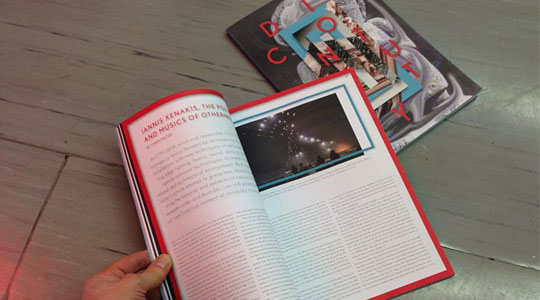CTM 2014 Dis Continuity Magazine

This special 104-page publication commemorating CTM's 15th edition presents new, critical approaches to experimental music and its history in essays and articles authored by curators, music journalists, cultural workers, theorists, and artists.
Common narratives of music’s radical evolution over the past century favour a few exceptional individuals, whose stories exemplify major revolutions and transitions in bold strokes. But this history is underwritten by the innovation of countless others whose ideas, often arising in unreceptive or antagonistic environments, have been ignored, suppressed, purposely destroyed, and eventually forgotten.
Adopting a less hierarchical perspective, the works included in this compendium illuminate select trajectories in experimental and electronic music that until now have remained under the radar, but continue to inform and influence music today – from individual case studies of pioneering artists such as Finnish technology innovator and futurist Erkki Kurenniemi to marginalized musical developments behind the Iron Curtain and excavations of cultural movements like the Russian noise revolution of the early 20th century. Supplemented by theoretical works by Wolfgang Ernst, Hillegonda C Rietveld, and others that re-imagine the concept of history itself, Dis Continuity reflects on the meaning of the growing tendency in many of today’s musical practises to interact with the past.
Still available – order now!
The CTM 2014 Magazine costs 8 € and is available in Berlin in selected book stores such as Pro QM, Motto, and Do You Read Me.
People outside Berlin can order the Magazine online via the Pro QM Online Shop.
Content Overview
Dis Continiuity
by Jan Rohlf
Generation Z: ReNoise – Experiments in Sound & Electronic Music in early 20th Century Russia
by Andrey Smirnov & Liubov Pchelkina
ReNoise: Reconstructing the Hidden History of Revolutionary Noise Music
by Konstantin Dudakov-Kashuro
Overlooked Progress
by Robert Mießner
Cosmic Flight: Electronic Pop Music in the GDR
by Florian Sievers
Erkki Kurenniemi
by Jennifer Lucy Allan
Iannis Xenakis, The Polytopes & Musics of Otherness
by Chris Salter
Image and Sound: Experimental Art Teaching in the Interstices Between Visual Art and Music
by Michael van Hoogenhuyze
Music for the Five Senses
by Frans Evers
Worlds of the Drone
by Marcus Boon
Coming to Terms with Sound
by Björn Gottstein
J’ai rêvé d’une musique étrange et belle qui ne soit jamais la meme ni tout à fait une autre
Thibault de Ruyter in conversation with Eliane Radigue
Chronopoetics of Techno-Archival Memory
by Wolfgang Ernst
Digital Audio: Remastering and Radical Revisionism
by Paul Purgas
Curating the Past, Creating the Future: DJ as Time Lord
by Hillegonda Rietveld
Sonic Cyberfeminism and its Discontents
by Annie Goh
101 Women in Electronic Music
by Antye Greie-Ripatti
Transmissions: Beaini//Cohen: A Case Study
by Katerina Leinhart
From Folk Culture to Open Culture: Continuity, Discontinuity, and the Musical Hack
by Peter Kirn
The Outernational Condition
by Ion Dumitrescu
The Death of World Music
by Johan Palme
Dis Continuity Spaces
Photo Spread of spaces then and now
Looking Beyond the Beat: DisContinuities in Berlin’s Musical Landscape
by Henning Lahmann
Anonymonth
by Mat Dryhurst
Digital Culture in the Afterglow
by Kristoffer Gansing
Dis-Contnuity & Presence of Mind
by Andreas L. Hofbauer
Addendum
We forgot to indicate the source of the he Adam Harper quote cited at the beginning of Jan Rohlf's article ("Our task is not to locate and manifest the one greatest musical work or locus of music, and plant it like a monument in human history."). It is taken from Adam Harper's article A New Manifesto for New Music, published in January 2013 in Gonzo Magazine.


